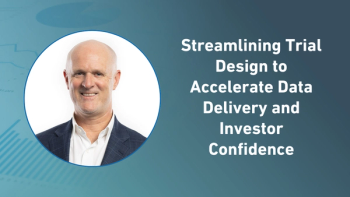
- Applied Clinical Trials-11-01-2009
- Volume 0
- Issue 0
To Market Faster In Silico Style
Changing current business models with the use of new advancements for more sustainability.
The economic environment of the last two years proved difficult for the previously almost immune pharma/biotech sector. Even as the world climbs slowly out of recession, aftershocks will be felt in the sector as governments seek to address health care costs that they cannot afford to allow to increase unchecked. Although prescription charges make up a relatively small percentage of the overall bill, around 10%, they have been targeted aggressively, with drugs companies already responding in some countries.
Andrew MacGarvey
In the United States, drug companies agreed to contribute $80 billion toward the cost of Medicare drugs over the next 10 years. The current business model for our drug companies is not sustainable, and a change of thinking is needed. One way to reduce costs is to reduce the cost of development. Until recently the options for achieving this were limited. But with the onset of Prediction, Preemption, and Personalization that will change.
Available advances
With drugs being targeted to specific populations, one can imagine the importance of in silico modeling increasing and becoming more widely accepted. Programs will then run more quickly, and the FDA and other regulators will approve drugs much earlier, once a response in the target population has been proven. It is then possible that the clinical phase will be accelerated.
This scenario will be very acceptable to health care providers, as the cost of development will be dramatically reduced, allowing for cheaper drugs. The win for pharma/biotech is one of improved cash flow, with revenues coming on stream far earlier than they do now. If patent protection rulings are static, then the negative effect on those revenues by generics or biosimilars is reduced by virtue of prolonged exclusivity.
It is fairly easy to see how all stakeholders could be satisfied by this model. The question is: Is it realistic to bring down the time to market of new drugs by allowing for targeted therapies?
Push comes to shove
I wonder if a parallel can be drawn with off-label use of drugs. With sophisticated in silico modeling providing credible information with respect to how the drug might act, and intelligently designed trials gathering extended volumes of data, the regulators may be comfortable approving drugs into targeted populations.
A report by Mark Ratner and Trisha Gura in the July 2008 issue of Nature Biotechnology estimates that "off-label use of cancer drugs runs from 50%-70% of total usage, and perhaps higher." In critical care, there is always additional pressure to get new treatments to patients. When sickness management is addressed in 10 years, if the technology in diagnostics has advanced sufficiently and more is known about how the drug will effect its population, the pressure to get new treatment to the patient will only increase.
With the economic and demographic challenges ahead, industry may have to rely on the benefit from a new approach. They can focus on accelerating the delivery of targeted therapies to specific populations. The main concern surrounding targeted medicine has been the cost. Can a return on investment be made when the market is limited? Under a model where sales begin at the two or three year point and where preclinical work has been accelerated, it may just be possible.
Andrew MacGarvey President Quanticate, Inc.
Articles in this issue
about 16 years ago
Applied Clinical Trials Digital Edition - November 2009about 16 years ago
Business and People Update November 2009about 16 years ago
Conducting Trials in Croatiaabout 16 years ago
Preparing for Postmarketabout 16 years ago
EDC Acceptance in Japanabout 16 years ago
Is an Investigative Site Shake-Out Imminent?about 16 years ago
Growth for Welsh Companiesabout 16 years ago
South Africa Todayabout 16 years ago
Health Issues Raise EU's Regulatory Profileabout 16 years ago
Safety Requirements Slow New Drug ApprovalsNewsletter
Stay current in clinical research with Applied Clinical Trials, providing expert insights, regulatory updates, and practical strategies for successful clinical trial design and execution.






.png)



.png)



.png)
.png)
